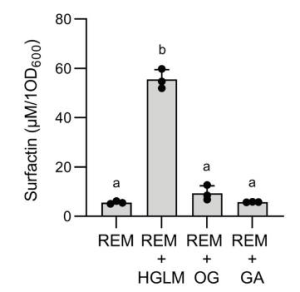A group from University of Liège‐Gembloux Agro‐Bio Tech, Gembloux, Belgium, etc. has reported Bacillus velezensis recognizes plant root cell pectin and thereby improve symbiotic relation.
https://pubmed.ncbi.nlm.nih.gov/34724831/
Molecular interactions driving the early steps of partnership establishment between plant roots and rhizobacteria are not yet fully understood. Authors have found that Bacillus velezensis, one of beneficial bacteria, recognizes plant root cell wall pectin in synergy with soluble root exudates, and thereby the bacterium stimulates the production of a specific surfactin-type lipopeptide as key components of its secretome to improve the partnership in the course of early colonization.
Actually, an 8-fold increase of the surfactin production was detected at the early exponential growth phase with homogalacturonan low methylated (HGLM) as shown below, however, the bacteria seem not to recognize oligomers with a lower polymerization degree (DP) than HGLM, as is clear from the fact that oligogalacturonides (OGs) did not stimulate surfactin biosynthesis. This might mean that longer polymers could indicate a healthy host suitable for bacterial colonization, while the monomers or low DP oligomers may reflect a dead or infected plant that is unable to adequately provide resources to the bacteria.

homogalacturonan low methylated (HGLM), DP of >150; oligogalacturonides (OG), DP of 15; galacturonic acid (GA), DP of 1; where REM means a root exudates mimicking medium.
But, there is no information about a lectin-like protein on the bacteria which can recognize the pectin backbone as a plant molecular pattern was not mentioned here anything.
